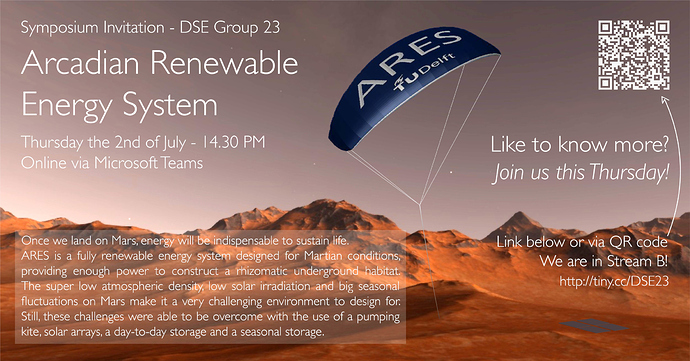Once we land on Mars, energy will be indispensable to sustain life. ARES is a fully renewable energy system designed for Martian conditions, providing enough power to construct a rhizomatic underground habitat. The super-low atmospheric density, low solar irradiation and big seasonal fluctuations on Mars make it a very challenging environment.
On Thursday, 2 July, at 14.30 (CET), we will present the results of our TU Delft Design Synthesis Exercise project: a pumping kite power system, solar arrays, a day-to-day storage and a seasonal storage. If you want to know more, please check into the live presentation during the online DSE Symposium: Go to http://tiny.cc/DSE23 and find is in stream B. We hope to see you on Thursday!
Fernando Corte Vargas, Márton Géczi, Siri Heidweiller, Marcel Kempers, Bart Klootwijk, Francesca van Marion, Dmitrij Mordasov, Lora Ouroumova, Esmée Terwindt, Daan Witte
1 Like
DSE2020_group_23_Final_Report.pdf
It would be great if this project were supervised in one hand or another by the great French Austronaut Thomas Pesquet https://twitter.com/Thom_astro.
1 Like
@PierreB That would indeed be great if we could get such VIP support! If anyone could put in a word for us we would greatly appreciate this.
1 Like
@Windy_Skies This is about the preprint of our accepted journal paper
L. Ouroumova, D. Witte, B. Klootwijk, E. Terwindt, F. van Marion, D. Mordasov, F. Corte Vargas, S. Heidweiller, M. Géczi, M. Kempers, R. Schmehl: “Combined Airborne Wind and Photovoltaic Energy System for Martian Habitats”. Spool, Cyber-physical Architecture #4 “Off-Earth Infrastructure”, accepted, 2021. arxiv:2104.09506 [astro-ph.IM]
which will appear in a few weeks. The journal paper summarizes the results of the TU Delft design synthesis exercise (Aerospace Engineering final BSc project) last spring. The focus of that project was the microgrid to power the underground Mars habitat. The AWE system was one of the components of the microgrid.
This spring, we launched a follow up project with 10 students continuing the work for another 10 weeks. The focus is now more on the AWE system. The fact that the Ingenuity drone just flew on Mars provides considerable tailwind to the project, additional media attention and a lot of extra motivation to the students.
2 Likes
